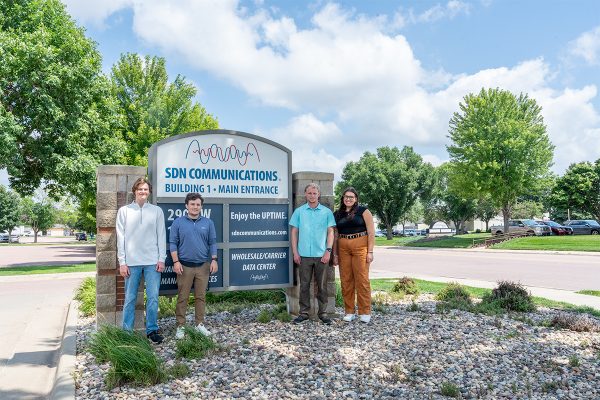Harold Parlet’s seven years with SDN Communications provides a good, ground-level reflection of the company’s growth.
Parlet, the manager of outside plant engineering, was recruited to SDN in 2006 after he retired from 36 years with Qwest (now CenturyLink) and its predecessor phone companies: Northwestern Bell and U.S. West.
When Parlet started, SDN was on the verge of a growth spurt that continues today. SDN employed about 50 people in the mid-2000s. The company employs three times as many people today.
“When I started, I was pretty much it. I was the outside plant engineer,” he says. “They needed a lot more fiber in the ground to continue their growth.”
Now, Parlet has five engineers working under him – four in Sioux Falls and one in Rapid City. He hires subcontracting firms to bury and splice fiber. His team of engineers oversees the installation, connection, and maintenance of high-speed, fiber-optic lines throughout the state.
On any given day, dozens of projects are under way. The summer construction season is particularly busy.
Big projects expand fiber network
Construction of the REED network was the first major project to come along after Parlet joined SDN. REED stands for the Research Education Economic Development network.
The REED network is a public-private partnership that created a data-transporting superhighway designed to link public universities and other research institutions in South Dakota.
The initial $11.8 million was funded by the Great Plains Education Foundation and the state. SDN contributed $10 million in incentives to help South Dakota meet its growing bandwidth needs.
The REED network connects South Dakota’s six public universities as well as institutions such as University Center in Sioux Falls and the Sanford Lab at Homestake in Lead. Bandwidth capable of carrying 50,000 megabits per second ensures that large amounts of information can be transmitted quickly and without fear of pipeline congestion.
An even bigger project came along three years ago: an economic stimulus grant under the federal Broadband Technologies Opportunities Program, or BTOP. SDN Communications received a $20.6 million grant in December 2009. The company contributed an additional $5 million to the project.
Grants were designed to improve broadband infrastructure in unserved and underserved areas, enhance broadband capacity at public centers and encourage sustainable broadband services.
SDN has used the grant to help add about 360 miles to its 1,850-mile fiber-optic network. That's a significant upgrade for the state's business infrastructure.
The BTOP program also has allowed SDN to increase broadband speeds to schools, libraries, hospitals, clinics, public safety agencies, government offices and National Guard facilities added to the network. Faster connections also were provided to institutions that already were part of the network.
Educators, others welcome improvements to broadband
People such as teachers in small towns seem especially appreciative when they get access to a higher-capacity broadband network, Parlet says.
“There’s so much more in the teaching world that they can do if they have the bandwidth,” he says. Watch a brief video, below, of higher broadband speed's impact on learning in Arlington.
Institutions such as clinics also have significantly enhanced potential to communicate and serve patients, he says. A remotely located clinic might, for example, be able to transport a patient’s X-ray to a medical expert for interpretation.
“What they can do in a clinic now compared to a few years ago is pretty amazing,” he says.
Construction work on the BTOP stimulus grant is wrapping up now. However, completing reviews and office duties related to the project might take a few more months.
Factors such as environmental regulations and bad weather complicated the construction timetable at times, especially in the beginning phases of the project.
“We met the challenges and got it done. It was a push right at the end,” says Parlet, a South Dakota native who served in the U.S. Coast Guard for five years.
Now that the work on the stimulus project is winding down, he is considering going back into retirement – possibly in the spring, when he will turn 70. That might be a good time to let a younger person take over leadership of outside engineering operation, he says.
There’s still a lot of work to do, though, he says. “We have to continue to expand.”



